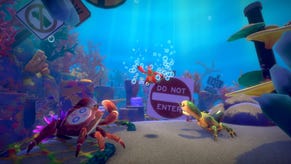On Discovering the Famicom Disk System: Nintendo's Alternate Reality Version of the NES
On the occasion of the Japan-only peripheral's 30th anniversary, Jeremy takes a journey through its twisted rendition of the familiar NES experience.
This article first appeared on USgamer, a partner publication of VG247. Some content, such as this article, has been migrated to VG247 for posterity after USgamer's closure - but it has not been edited or further vetted by the VG247 team.
Throughout the late ’80s and into the ’90s, the Nintendo Entertainment System occupied a place of honor in the American living room. The console sat quietly next to the enormous tube-style televisions of the day, a simple-looking box in two tones of grey, elegant in its understated simplicity.
Despite its unassuming appearance, the NES offered its share of mysteries as well. What kind of name was "Nintendo"? Why were so many games bearing the "seal of quality" so terrible? And most of all, what was up with that expansion port cover on the console's bottom?
I understood the concept of expansion ports, of course. My family's first computer had been a console expansion — the Coleco ADAM, which connected to a socket on the ColecoVision system similar to the one on the NES — and I'd hoped we'd eventually pick up the Coleco expansion that turned the console into an ersatz Atari 2600. (We never did.)
The port's presence on the NES confused me, however, because the system didn't seem to have any devices that took advantage of it. Those wild launch peripherals, the Zapper gun and R.O.B. (the "robot operating buddy") plugged directly into the controller ports, and even later devices like the Miracle Piano Teaching System didn't need the underside expansion. In the end, so far as I could tell, it went completely unused. Later, I learned of a crazy plan for the Minnesota State Lottery to use it as a modem adapter, but that product fell through... presumably due to the sheer, bizarre randomness — not to mention regional specificity! — of such a project.
As a kid, I didn't know about the origins of the NES. I had no idea the system was originally created in Japan, blind as I was to America's late-’80s xenophobic crusades against the system. So I didn't know that the Japanese NES, the Famicom, actually did see ADAM-like expansions, including a keyboard for programming in BASIC, and a cassette recorder for storing data — peripherals Nintendo initially planned to localize along with the console itself, back when it was to be called the AVS (Advanced Video System) rather than the NES. Those plans were scrapped when retailers made it clear they had no interest in another clumsy game/computer hybrid sitting around as dead stock. And fair enough; my family owned an ADAM because retailers slashed prices on them to rock-bottom in desperation to clear them out.
Interestingly, though, despite the Famicom's patchwork computer aspect, the NES's expansion port didn't exist on that console. Not precisely, anyway. On the original hardware, Nintendo incorporated the expansion port's capabilities into both the cartridge slot and a special controller port on the front of the system. When designing the NES, though, Masayuki Uemura and his engineers reworked the hardware's expansion format. Some elements were integrated into the standard controller ports — a natural evolution as Nintendo moved away from the hard-wired controllers present on the Japanese machine. Other elements, however, were shuffled around to the bottom of the machine to sit inside that vestigial and ultimately pointless expansion port.
This overhaul had repercussions on the NES library for years to come. Soon after the NES's launch in America, Japanese publishers began to brew up special cartridges that made use of the expansion pins that were removed from the Famicom cartridge slot when it was reworked into the NES. As a result, American gamers ended up missing out on some of the more ambitious Famicom games, which couldn't run on NES hardware. One of Konami's games even came with its own FM synthesis chip installed, giving it audio capabilities more on par with the Sega Genesis!
While this revision led to certain Japanese versions of games becoming infamously superior to American releases, particularly Castlevania III, Nintendo's engineers hadn't rearranged the hardware frivolously. The NES cartridge slot pinout changes resulted in part from Nintendo's desire to gain control over game licensing, as the Japanese Famicom market became flooded by horrible, low-quality third-party software — the same phenomenon that had tanked the Atari 2600 in the U.S. Determined to nip that crisis in the bud, the company added a security lockout chip to the U.S., forcing prospective third parties to become official licensees and allow Nintendo to handle game manufacturing. The Japanese cartridge port expansion pins were replaced by security chip connectors in the NES.
The other factor had to do with realities of the American console business. Retail buyers had rejected the AVS because it looked like yet another game system in the vein of the ones that were cluttering retail and gathering dust despite their 25 50 75% OFF stickers; Nintendo's solution was to switch up the NES hardware so it looked like no other console before it. The inclusion of R.O.B. and the Zapper as pack-in hardware was one aspect of this plan, but an equally essential tactic involved changing the system's physical design so it no longer resembled a traditional console. The slim, tapered design of the Famicom became a chunky grey box accented with a glossy black grille, and the top-loading cartridge slot was turned sideways in favor of a spring-loaded, front-facing design that resembled a VHS deck.
The front-loader gimmick ultimately proved to be more trouble than it was worth, but Nintendo saw it as a necessity to infiltrate American retail shops. Whatever long-term compromises it involved came as a tradeoff for getting the console to consumers at all. The design change undoubtedly necessitated the removal of expansion capabilities from the cartridge slot, though; the need to insert NES carts completely into the console meant that non-standardized carts — like the ones used for Famicom expansions — would be physically incompatible with the NES.
Nintendo almost certainly didn't arrive at the decision to relocate those extra pins to the bottom of the console by chance. The NES hardware launched in America, in limited numbers, in October 1985. Four months later, the Famicom received its greatest and most spectacular add-on peripheral ever, a device that practically counts as a separate platform all on its own: The Famicom Disk System.










